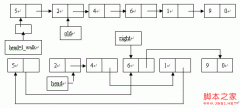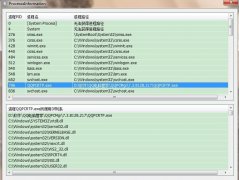STL组件之迭代器(1)(5)
前推迭代器
前推迭代器能够读写数据值,并能够向前推进到下一个值。但是没法递减。replace()算法显示了前推迭代器的使用方法。
- template <class ForwardIterator, class T>
- void replace (ForwardIterator first,
- ForwardIterator last,
- const T& old_value,
- const T& new_value);
使用replace()将[first,last]范围内的所有值为old_value的对象替换为new_value。:
- replace(vdouble.begin(), vdouble.end(), 1.5, 3.14159);
双向迭代器
双向迭代器要求能够增减。如reverse()算法要求两个双向迭代器作为参数:
- template <class BidirectionalIterator>
- void reverse (BidirectionalIterator first,
- BidirectionalIterator last);
使用reverse()函数来对容器进行逆向排序:
- reverse(vdouble.begin(), vdouble.end());
随机访问迭代器
随机访问迭代器能够以任意顺序访问数据,并能用于读写数据(不是const的C++指针也是随机访问迭代器)。STL的排序和搜索函数使用随机访问迭代器。随机访问迭代器可以使用关系操作符作比较。
random_shuffle() 函数随机打乱原先的顺序。申明为:
- template <class RandomAccessIterator>
- void random_shuffle (RandomAccessIterator first,
- RandomAccessIterator last);
使用方法:
- random_shuffle(vdouble.begin(), vdouble.end());
迭代器技术
要学会使用迭代器和容器以及算法,需要学习下面的新技术。
流和迭代器
本书的很多例子程序使用I/O流语句来读写数据。例如:
- int value;
- cout << "Enter value: ";
- cin >> value;
- cout << "You entered " << value << endl;
对于迭代器,有另一种方法使用流和标准函数。理解的要点是将输入/输出流作为容器看待。因此,任何接受迭代器参数的算法都可以和流一起工作。
Listing 4. outstrm.cpp
- #include <iostream.h>
- #include <stdlib.h> // Need random(), srandom()
- #include <time.h> // Need time()
- #include <algorithm> // Need sort(), copy()
- #include <vector> // Need vector
- using namespace std;
- void Display(vector<int>& v, const char* s);
- int main()
- {
- // Seed the random number generator
- srandom( time(NULL) );
- // Construct vector and fill with random integer values
- vector<int> collection(10);
- for (int i = 0; i < 10; i++)
- collection[i] = random() % 10000;;
- // Display, sort, and redisplay
- Display(collection, "Before sorting");
- sort(collection.begin(), collection.end());
- Display(collection, "After sorting");
- return 0;
- }
- // Display label s and contents of integer vector v
- void Display(vector<int>& v, const char* s)
- {
- cout << endl << s << endl;
- copy(v.begin(), v.end(),
- ostream_iterator<int>(cout, "t"));
- cout << endl;
- }
函数Display()显示了如何使用一个输出流迭代器。下面的语句将容器中的值传输到cout输出流对象中:
- copy(v.begin(), v.end(),
- ostream_iterator<int>(cout, "t"));
第三个参数实例化了ostream_iterator<int>类型,并将它作为copy()函数的输出目标迭代器对象。“t”字符串是作为分隔符。运行结果:
- $ g++ outstrm.cpp
- $ ./a.out
- Before sorting
- 677 722 686 238 964 397 251 118 11 312
- After sorting
- 11 118 238 251 312 397 677 686 722 964
这是STL神奇的一面『确实神奇』。为定义输出流迭代器,STL提供了模板类ostream_iterator。这个类的构造函数有两个参数:一个ostream对象和一个string值。因此可以象下面一样简单地创建一个迭代器对象:
- ostream_iterator<int>(cout, "n")
该迭代起可以和任何接受一个输出迭代器的函数一起使用。
插入迭代器
插入迭代器用于将值插入到容器中。它们也叫做适配器,因为它们将容器适配或转化为一个迭代器,并用于copy()这样的算法中。例如,一个程序定义了一个链表和一个矢量容器:
- list<double> dList;
- vector<double> dVector;
通过使用front_inserter迭代器对象,可以只用单个copy()语句就完成将矢量中的对象插入到链表前端的操作:
- copy(dVector.begin(), dVector.end(), front_inserter(dList));
三种插入迭代器如下:
- 普通插入器 将对象插入到容器任何对象的前面。
- Front inserters 将对象插入到数据集的前面——例如,链表表头。
- Back inserters 将对象插入到集合的尾部——例如,矢量的尾部,导致矢量容器扩展。
使用插入迭代器可能导致容器中的其他对象移动位置,因而使得现存的迭代器非法。例如,将一个对象插入到矢量容器将导致其他值移动位置以腾出空间。一般来说,插入到象链表这样的结构中更为有效,因为它们不会导致其他对象移动。
Listing 5. insert.cpp
- #include <iostream.h>
- #include <algorithm>
- #include <list>
- using namespace std;
- int iArray[5] = { 1, 2, 3, 4, 5 };
- void Display(list<int>& v, const char* s);
- int main()
- {
- list<int> iList;
- // Copy iArray backwards into iList
- copy(iArray, iArray + 5, front_inserter(iList));
- Display(iList, "Before find and copy");
- // Locate value 3 in iList
- list<int>::iterator p =
- find(iList.begin(), iList.end(), 3);
- // Copy first two iArray values to iList ahead of p
- copy(iArray, iArray + 2, inserter(iList, p));
- Display(iList, "After find and copy");
- return 0;
- }
- void Display(list<int>& a, const char* s)
- {
- cout << s << endl;
- copy(a.begin(), a.end(),
- ostream_iterator<int>(cout, " "));
- cout << endl;
- }
运行结果如下:
- $ g++ insert.cpp
- $ ./a.out
- Before find and copy
- 5 4 3 2 1
- After find and copy
- 5 4 1 2 3 2 1
可以将front_inserter替换为back_inserter试试。
如果用find()去查找在列表中不存在的值,例如99。由于这时将p设置为past-the-end 值。最后的copy()函数将iArray的值附加到链表的后部。
混合迭代器函数
在涉及到容器和算法的操作中,还有两个迭代器函数非常有用:
- advance() 按指定的数目增减迭代器。
- distance() 返回到达一个迭代器所需(递增)操作的数目。
例如:
- list<int> iList;
- list<int>::iterator p =
- find(iList.begin(), iList.end(), 2);
- cout << "before: p == " << *p << endl;
- advance(p, 2); // same as p = p + 2;
- cout << "after : p == " << *p << endl;
- int k = 0;
- distance(p, iList.end(), k);
- cout << "k == " << k << endl;
advance()函数接受两个参数。第二个参数是向前推进的数目。对于前推迭代器,该值必须为正,而对于双向迭代器和随机访问迭代器,该值可以为负。
使用 distance()函数来返回到达另一个迭代器所需要的步骤。
注意:distance()函数是迭代的,也就是说,它递增第三个参数。因此,你必须初始化该参数。未初始化该参数几乎注定要失败。
希望通过本文的介绍,能够给你帮助。
- 上一篇:详细介绍C/C++时间函数使用方法(1)
- 下一篇:STL组件之算法(1)





